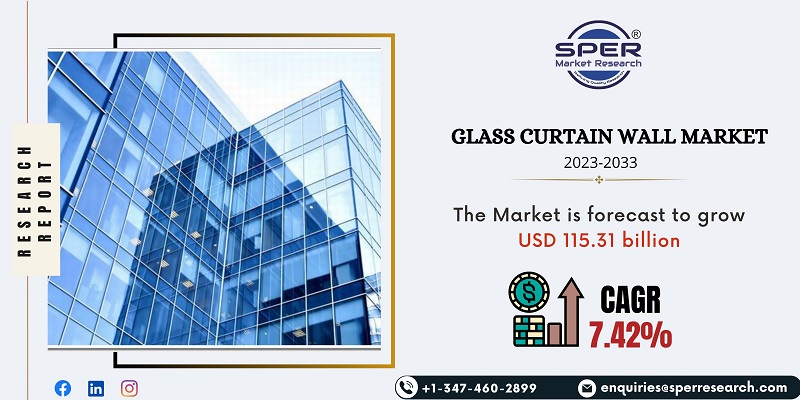
Glass Curtain Wall Market Growth, Size, Trends, Revenue, Price, Demand and Future Competition
Glass Curtain Wall Market Size- By Type, By Product Type, By End User- Regional Outlook, Competitive Strategies and Segment Forecast to 2033
| Published: Jun-2023 | Report ID: FMCG2375 | Pages: 1 - 234 | Formats*: |
| Category : Consumer & Retail | |||
- Increasing Construction Activities: The growth of the construction industry, particularly in developing regions, is a major driver for the glass curtain wall market. Urbanization, population growth, and infrastructure development projects, including commercial complexes, residential buildings, and institutional structures, fuel the demand for glass curtain walls.
- Energy Efficiency and Sustainability: Glass curtain walls are known for their energy-efficient properties as they allow natural light to penetrate buildings, reducing the need for artificial lighting. The growing emphasis on energy conservation and sustainability in construction practices has led to a higher demand for energy-efficient building materials, including glass curtain walls.


| Report Metric | Details |
| Market size available for years | 2019-2033 |
| Base year considered | 2022 |
| Forecast period | 2023-2033 |
| Segments covered | By Type, By Product Type, By End User |
| Regions covered | Asia-Pacific, Europe, Middle East and Africa, North America, Latin America |
| Companies Covered | AGC Inc, Beijing Northglass Technologies Co. Ltd, Cardinal Glass Industries, Inc, Central Glass Co. Ltd, Dellner Romag Ltd, Fuyao Glass Industry Group Co. Ltd., Guangzhou Topo Glass Co. Ltd., Nippon Sheet Glass Co. Ltd., Qingdao Tsing Glass Co. Limited, Saint-Gobain, SCHOTT AG , Sisecam , Taiwan Glass Ind. Corp., Xinyi Glass Holdings Limited, Others |
| By Type |
|
| By Product Type |
|
| By End User |
|
| By Type |
|
- Commercial Buildings
- Hospitality Industry
- Institutional Buildings
- Residential Buildings
- Transportation Infrastructure
- Global Glass Curtain Wall Market Size (FY’2023-FY’2033)
- Overview of Global Glass Curtain Wall Market
- Segmentation of Global Glass Curtain Wall Market By Type (Unitized Curtain Wall, Stick Curtain Wall)
- Segmentation of Global Glass Curtain Wall Market By Product Type (Double Glazed Type, Three Glazed Type, Single Glazed Type)
- Segmentation of Global Glass Curtain Wall Market By End User (Residential, Commercial, Public Sectors)
- Statistical Snap of Global Glass Curtain Wall Market
- Expansion Analysis of Global Glass Curtain Wall Market
- Problems and Obstacles in Global Glass Curtain Wall Market
- Competitive Landscape in the Global Glass Curtain Wall Market
- Impact of COVID-19 and Demonetization on Global Glass Curtain Wall Market
- Details on Current Investment in Global Glass Curtain Wall Market
- Competitive Analysis of Global Glass Curtain Wall Market
- Prominent Players in the Global Glass Curtain Wall Market
- SWOT Analysis of Global Glass Curtain Wall Market
- Global Glass Curtain Wall Market Future Outlook and Projections (FY’2023-FY’2033)
- Recommendations from Analyst
1.1. Scope of the report1.2. Market segment analysis
2.1. Research data source
2.1.1. Secondary Data2.1.2. Primary Data2.1.3. SPER’s internal database2.1.4. Premium insight from KOL’s
2.2. Market size estimation
2.2.1. Top-down and Bottom-up approach
2.3. Data triangulation
4.1. Driver, Restraint, Opportunity and Challenges analysis
4.1.1. Drivers4.1.2. Restraints4.1.3. Opportunities4.1.4. Challenges
4.2. COVID-19 Impacts of the Global Glass Curtain Wall Market
5.1. SWOT Analysis
5.1.1. Strengths5.1.2. Weaknesses5.1.3. Opportunities5.1.4. Threats
5.2. PESTEL Analysis
5.2.1. Political Landscape5.2.2. Economic Landscape5.2.3. Social Landscape5.2.4. Technological Landscape5.2.5. Environmental Landscape5.2.6. Legal Landscape
5.3. PORTER’s Five Forces
5.3.1. Bargaining power of suppliers5.3.2. Bargaining power of buyers5.3.3. Threat of Substitute5.3.4. Threat of new entrant5.3.5. Competitive rivalry
5.4. Heat Map Analysis
6.1. Global Glass Curtain Wall Market Manufacturing Base Distribution, Sales Area, Product Type6.2. Mergers & Acquisitions, Partnerships, Product Launch, and Collaboration in Global Glass Curtain Wall Market
7.1. Global Glass Curtain Wall Market Value Share and Forecast, By Type, 2023-20337.2. Stick Curtain Wall7.3. Unitized Curtain Wall
8.1. Global Glass Curtain Wall Market Value Share and Forecast, By Product Type, 2023-20338.2. Double Glazed Type8.3. Three Glazed Type8.4. Single Glazed Type
9.1. Global Glass Curtain Wall Market Value Share and Forecast, By End User, 2023-20339.2. Commercial9.3. Public Sectors9.4. Residential
10.1. Global Glass Curtain Wall Market Size and Market Share
11.1. Global Glass Curtain Wall Market Size and Market Share By Type (2019-2026)11.2. Global Glass Curtain Wall Market Size and Market Share By Type (2027-2033)
12.1. Global Glass Curtain Wall Market Size and Market Share By Product Type (2019-2026)12.2. Global Glass Curtain Wall Market Size and Market Share By Product Type (2027-2033)
13.1. Global Glass Curtain Wall Market Size and Market Share By End User (2019-2026)13.2. Global Glass Curtain Wall Market Size and Market Share By End User (2027-2033)
14.1. Global Glass Curtain Wall Market Size and Market Share By Region (2019-2026)14.2. Global Glass Curtain Wall Market Size and Market Share By Region (2027-2033)14.3. Asia-Pacific
14.3.1. Australia14.3.2. China14.3.3. India14.3.4. Japan14.3.5. South Korea14.3.6. Rest of Asia-Pacific
14.4. Europe
14.4.1. France14.4.2. Germany14.4.3. Italy14.4.4. Spain14.4.5. United Kingdom14.4.6. Rest of Europe
14.5. Middle East and Africa
14.5.1. Kingdom of Saudi Arabia14.5.2. United Arab Emirates14.5.3. Rest of Middle East & Africa
14.6. North America
14.6.1. Canada14.6.2. Mexico14.6.3. United States
14.7. Latin America
14.7.1. Argentina14.7.2. Brazil14.7.3. Rest of Latin America
15.1. AGC Inc
15.1.1. Company details15.1.2. Financial outlook15.1.3. Product summary15.1.4. Recent developments
15.2. Beijing Northglass Technologies Co. Ltd
15.2.1. Company details15.2.2. Financial outlook15.2.3. Product summary15.2.4. Recent developments
15.3. Cardinal Glass Industries, Inc
15.3.1. Company details15.3.2. Financial outlook15.3.3. Product summary15.3.4. Recent developments
15.4. Central Glass Co. Ltd
15.4.1. Company details15.4.2. Financial outlook15.4.3. Product summary15.4.4. Recent developments
15.5. Dellner Romag Ltd
15.5.1. Company details15.5.2. Financial outlook15.5.3. Product summary15.5.4. Recent developments
15.6. Fuyao Glass Industry Group Co., Ltd
15.6.1. Company details15.6.2. Financial outlook15.6.3. Product summary15.6.4. Recent developments
15.7. Guangzhou Topo Glass Co., Ltd
15.7.1. Company details15.7.2. Financial outlook15.7.3. Product summary15.7.4. Recent developments
15.8. Nippon Sheet Glass Co., Ltd
15.8.1. Company details15.8.2. Financial outlook15.8.3. Product summary15.8.4. Recent developments
15.9. Qingdao Tsing Glass Co. Limited
15.9.1. Company details15.9.2. Financial outlook15.9.3. Product summary15.9.4. Recent developments
15.10. Saint-Gobain
15.10.1. Company details15.10.2. Financial outlook15.10.3. Product summary15.10.4. Recent developments
15.11. SCHOTT AG
15.11.1. Company details15.11.2. Financial outlook15.11.3. Product summary15.11.4. Recent developments
15.12. Sisecam
15.12.1. Company details15.12.2. Financial outlook15.12.3. Product summary15.12.4. Recent developments
15.13. Taiwan Glass Ind. Corp.
15.13.1. Company details15.13.2. Financial outlook15.13.3. Product summary15.13.4. Recent developments
15.14. Xinyi Glass Holdings Limited
15.14.1. Company details15.14.2. Financial outlook15.14.3. Product summary15.14.4. Recent developments
15.15. Others
SPER Market Research’s methodology uses great emphasis on primary research to ensure that the market intelligence insights are up to date, reliable and accurate. Primary interviews are done with players involved in each phase of a supply chain to analyze the market forecasting. The secondary research method is used to help you fully understand how the future markets and the spending patterns look likes.
The report is based on in-depth qualitative and quantitative analysis of the Product Market. The quantitative analysis involves the application of various projection and sampling techniques. The qualitative analysis involves primary interviews, surveys, and vendor briefings. The data gathered as a result of these processes are validated through experts opinion. Our research methodology entails an ideal mixture of primary and secondary initiatives.



Frequently Asked Questions About This Report
PLACE AN ORDER
Year End Discount
Sample Report
Pre-Purchase Inquiry
NEED CUSTOMIZATION?
Request CustomizationCALL OR EMAIL US
100% Secure Payment






Related Reports
Our Global Clients
Our data-driven insights have influenced the strategy of 200+ reputed companies across the globe.




















